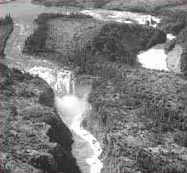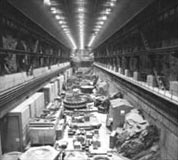Ideal Site and Bone of Contention
Churchill Falls
Ideal site
Since the first hydrographic surveys of the Hamilton River (later renamed the Churchill) in the 1920s, it was known that the river had the ideal conditions for building a powerful hydroelectric plant. The rate of flow was substantial. The head was as high as the Eiffel Tower or the Empire State Building: 320 metres over the final 30 kilometres of the river’s course. The last stage of the drop was a 75-metre waterfall, one and a half times the height of Niagara Falls. And there was solid rock everywhere to provide a foundation for the retaining works and the generating station.
Bone of contention
The generating station had barely produced its first kilowatthours when, in 1971, Newfoundland contested the validity of the contract binding the Churchill Falls (Labrador) Corporation [CF(L)Co] (Newfoundland and Labrador Hydro Corporation from 1974 on) to Hydro-Québec until 2041. This was the beginning of a legal saga played out in the courts of Newfoundland and Québec and eventually before the Supreme Court of Canada, which, in a unanimous decision in 1984, finally put an end to the debate. Newfoundland’s Reversion Act, under which the provincial government was attempting to revoke the rights of CF(L)Co over the Churchill River and transfer ownership of the hydroelectric facilities to the province, was declared unconstitutional.

